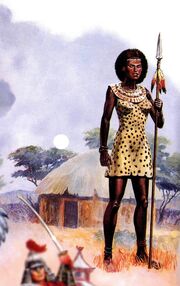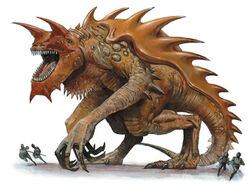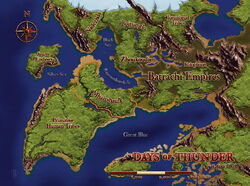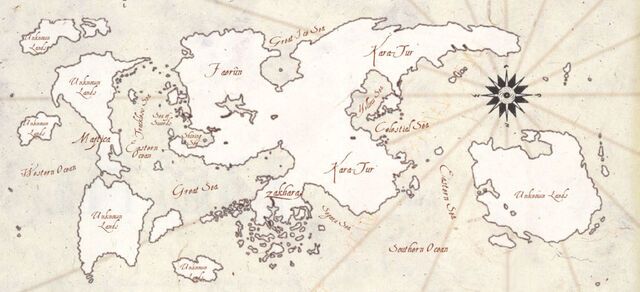Katashaka was a continent a long distance to the southwest of Faerûn.[2] In some outlandish old stories, it was called the "Dark Continent".[1]
Geography[]
There were highlands in the south.[2]
There was a port called Taerloon.[3]
Inhabitants[]

Nkonzi of the Anaconda in Katashaka.
It was the original home of several human tribes of the Chultan Peninsula, including the Eshowe, Tabaxi, and Thinguth.[2] The Tabaxi language had its roots here.[1]
The Anaconda mercenary company originated in Katashaka. Led by Nkonzi Maru, a ranger, and Kwanza Maru, a priest, they operated in the Heartlands of Faerûn in the mid–14th century DR.[4]
The amazon marines that made up a large portion of the planes-sailing Ebony Queen's crew under Captain Soot were related to the Anaconda, and thus likely also hailed from Katashaka. These warrior women used similar tactics and weaponry.[5][6][note 1]
The mage Shalane hailed from Taerloon in Katashaka. She was among those who tutored Elminster in magic in the early 7th century DR.[3][note 2]
Beliefs[]
Around −3000 DR, the ancient Tabaxi tribes of Katashaka worshiped a deity known as Olurobo and his children, called the nyama-nummo. One nyama-nummo was Akongo, a particularly perfidious entity dwelling in the southern highlands.[2][note 3]

The Sleeper wakes up hungry.
However, the greatest of the nyama-nummo was known as the Sleeper—the terrible tarrasque[note 4]—who dwelled in the Palace of the Alliz-Dren. She reigned over the lands of the Tabaxi and supposedly favored them over the other tribes. In turn, they chose one of their own at birth to be named Tarasajok, meaning "She Who Watches over the Sleeper"—and who had the honor of being first to be eaten by her upon awakening on the next Night of Feasting.[2][note 5]
There were also believed to be spirits.[2][note 6]
The Anaconda worshiped a snake god.[4]
History[]
Ancient History[]

A map of Merrouroboros, showing the part that would become Katashaka in the south-west.
During the ancient Days of Thunder (−30,000 DR to −35,000 DR), when the creator races reigned over Abeir-Toril, the land that would become Katashaka was little touched by them. Instead, it was home to tribes of the first humans. At this time, the humans of Toril were still primitive, even ape-like, dwelling in caves and using simple tools.[7]
Over the millennia, Katashaka came to be home to nine distinct human tribes: the Tabaxi, the Eshowe, the Thinguth, and others.[2][8]
In Tabaxi legend, one season, the Sleeper desired vengeance against an ancient enemy and summoned the greatest warriors of the nine tribes to follow her into battle in Mhairshaulk (c. −34,800 DR to c. −24,000 DR). Apparently defeated, the Sleeper returned in a rage, went on a rampage, and devoured four nyama-nummo on the Night of Feasting, before finally returning to sleep and recuperate in the Palace of Alliz-Dren. She would awaken twenty-three more times, and ever more angry and hungry.[2][note 7]
Eventually, the continent of Katashaka was split from the former super-continent of Merrouroboros in the great cataclysm known as the First Sundering, dated to around −17,600 DR. Faerûn and Maztica were separated in the same event.[9][10] The Tabaxi of Katashaka called this the Great Rending.[2][note 8]
Around −3000 DR, across the sea in Faerûn, the couatls were dwindling in number and desired to halt the spread of the yuan-ti into the western end of the Chultan Peninsula. Searching for another people to take their place, the winged serpents eventually chose the humans of Katashaka, and went to them to preach of their god, Ubtao.[2][8] The couatl Ecatzin came to the Tabaxi. Although initially resistant, fearing the feathered serpent to be a minion of Akongo, some of the tribe gradually came to accept the couatl's words and to learn a little of its language, while a chosen few like Oyai even learned a forbidden magic called matumbe. But they still dreaded the Sleeper's imminent awakening.[2]
Finally, on the next Night of Feasting at the end of a millennium, Ubtao blessed Oyai, naming her Negus Negusti and Bara, right before the Sleeper awoke with a roar and came to devour her. But she used the matumbe magic to halt, crush, and slay the Sleeper. That night, many liberated and joyous Tabaxi pledged themselves to Ubtao, as Ecatzin named them Ubtao's blessed children.[2]
Soon after, in −2809 DR, peoples of the Tabaxi, Eshowe, Thinguth, and several others who'd accepted the faith of Ubtao went with the couatls in a great pilgrimage over the ocean in some 300 canoa (canoes). Landing on the Wild Coast, they journeyed into the Jungles of Chult and met their new god at the Peaks of Flame. They would go on to settle much of the peninsula, and having lived free of oppression, they inspired the neighboring Lapal tribes to revolt against the yuan-ti.[2][8] Oyai's story of Katashaka would be recorded in the Teachings of Ubtao, stored in the vaults of the Maze of Life in their new city, Mezro.[2]
Appendix[]
Background[]
In its entry on the Anaconda, Gold & Glory refers only to "an island far to the southwest". This could've been the Chultan Peninsula, but that is of course not an island. The "Speaking in Tongues" article in Dragon Magazine Annual 1999 uses this to introduce a sub-Saharan-like so-called "Dark Continent" where the human Tabaxi tribe originated. It suggests DMs adapt the unofficial fantasy-Africa "Dark Continent" outlined in Dragon #189, proposing an island-continent the size of Australia south of Nimbral and west of Zakhara. In The Grand History of the Realms, this land is finally named Katashaka, based on fanon lore in the earlier fan-made A Grand History of the Realms by Brian R. James. By comparing the lore with the map of Merrouroboros, above, Katashaka can be identified as the large continent labeled "Unknown Lands" in the bottom-left corner of the map of Toril shown on this page.
See Also[]
Notes[]
- ↑ Although not specified, this connection suggests Captain Soot and Ebony Queen may originate in Katashaka too.
- ↑ Ed Greenwood mentions "a port called Taerloon on a large continent far WSW of Chult (S of Laerakond)." While Laerakond did not exist on Toril at the time (presumably the prior Maztica is intended) and the continent is unnamed, this is presumed to be Katashaka, as it is the largest and most westerly of the unidentified continents southwest of Faerûn. Ed would later introduce another southwestern continent, Arandron, which may be intended instead.
- ↑ The nyama-nummo are named after elements of the religion of the Dogon people of Mali, with the concept of nyama (roughly, human nature) and the Nummo spirits or deities.
- ↑ While the Sleeper is not defined in the text of the passage on page 30 of the The Grand History of the Realms, the accompanying image shows a tarrasque, with the caption "The Sleeper awakens". However, the art in Grand History is all reused from prior sourcebooks and often inappropriate. Nevertheless, in the original fan-work A Grand History of the Realms, an entity called "Tarrasque" who reigned over Katashaka is mentioned. Moreover, the name Tarasajok is suggestive of the tarrasque. Thus, it is assumed a tarrasque, or something very like one, was indeed intended.
- ↑ A Night of Feasting occurs at "the millennium end", suggesting they occur once every thousand years, but the sleep schedule of a tarrasque is generally noted to be unpredictable and more frequent.
- ↑ These spirits may be the same as the nyama-nummo.
- ↑ If this is every thousand years, then a span of 23,000 years is covered, and the battle occurred around −25,800 DR, which is within the time of Mhairshaulk when dominated by yuan-ti.
- ↑ The date and meaning is ambiguous, but the "Great Rending" is believed to most likely refer to the break-up of the continents. An alternative is the splitting of the tribes departing for Chult later.
References[]
- ↑ 1.0 1.1 1.2 Thomas M. Costa (1999). “Speaking in Tongues”. In Dave Gross ed. Dragon Annual #4 (TSR, Inc) (4)., pp. 26, 29.
- ↑ 2.00 2.01 2.02 2.03 2.04 2.05 2.06 2.07 2.08 2.09 2.10 2.11 2.12 2.13 Brian R. James, Ed Greenwood (September 2007). The Grand History of the Realms. Edited by Kim Mohan, Penny Williams. (Wizards of the Coast), pp. 29–30. ISBN 978-0-7869-4731-7.
- ↑ 3.0 3.1 Ed Greenwood (2020-03-08). Shalane of Taerloon (Tweet). theedverse. Twitter. Archived from the original on 2021-05-26. Retrieved on 2021-05-26.
- ↑ 4.0 4.1 Tim Beach (1992). Gold & Glory. (TSR, Inc), pp. 23–24. ISBN 1-56076-334-5.
- ↑ Wolfgang Baur (November 1993). Secrets of the Lamp. Genie Lore. (TSR, Inc.), p. 11. ISBN 978-1560766476.
- ↑ Wolfgang Baur (1993). Secrets of the Lamp (Cardsheets). (TSR, Inc.), p. 3. ISBN 1-56076-647-6.
- ↑ Brian R. James, Ed Greenwood (September 2007). The Grand History of the Realms. Edited by Kim Mohan, Penny Williams. (Wizards of the Coast), pp. 5, 6. ISBN 978-0-7869-4731-7.
- ↑ 8.0 8.1 8.2 Ed Greenwood, Eric L. Boyd, Darrin Drader (July 2004). Serpent Kingdoms. (Wizards of the Coast), pp. 121–122. ISBN 0-7869-3277-5.
- ↑ Brian R. James, Ed Greenwood (September 2007). The Grand History of the Realms. Edited by Kim Mohan, Penny Williams. (Wizards of the Coast), p. 10. ISBN 978-0-7869-4731-7.
- ↑ Bruce R. Cordell, Ed Greenwood, Chris Sims (August 2008). Forgotten Realms Campaign Guide. Edited by Jennifer Clarke Wilkes, et al. (Wizards of the Coast), pp. 42–43. ISBN 978-0-7869-4924-3.
Connections[]
Landmasses: Anchorome • Evermeet • Faerûn • Kara-Tur • Katashaka • Laerakond • Maztica • Merrouroboros • Osse • Zakhara
Seas and Oceans: Celestial Sea • Eastern Ocean • Eastern Sea • Great Ice Sea • Great Sea • Sea of Fallen Stars • Sea of Swords • Segara Sea • Shining Sea • Silver Sea • Southern Ocean • Trackless Sea • Western Ocean • Yellow Sea


